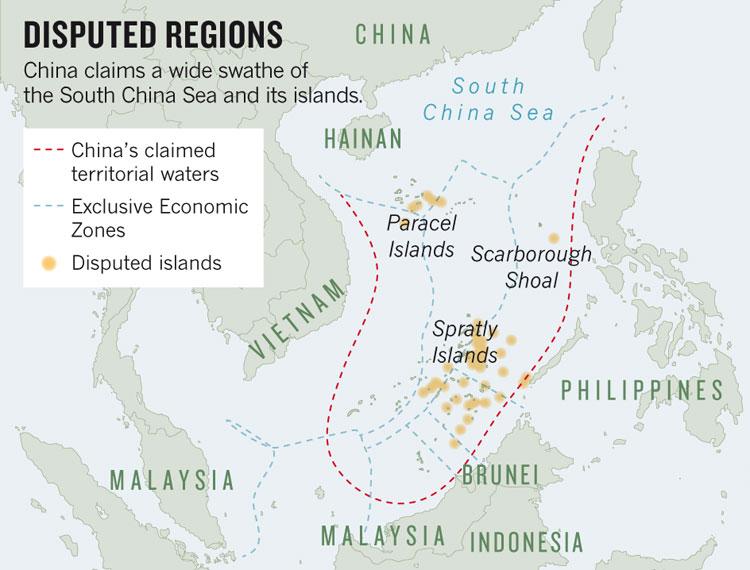Date: Tue, 20 Oct 2015 00:05:36 +0200

Map: Council on Foreign Relations
Waters are heating up again in the South China Sea, as Vietnamese authorities this week accused a Chinese vessel of sinking a Vietnamese fishing boat near the disputed Paracel (Xisha in Chinese, Hoang Sa in Vietnamese) islands on September 29. Vietnam, Taiwan and China all claim the Paracel islands, which consist of some 130 small coral islands and reefs, which were occupied and are now controlled by China after defeating the South Vietnamese navy in 1974.
The sinking of the Vietnamese boat, according to Phan Huy Hoang, an official in the central Vietnamese province of Quang Ngai, occurred as a result of a Chinese ship slammed into the boat. Five Chinese men then boarded and proceeded to steal navigation devices, fishing equipment and their 2-ton catch of fish. The boat eventually sank some 12 hours later and the fishermen resorted to floating in their life vests for another four hours before being rescued.
According to Hoang, more than 20 Vietnamese fishing boats have been attacked by Chinese vessels this year. On June 19, a Vietnamese fishing boat operating off the Hoang Sa archipelago was boarded by a Chinese crew, which destroyed its fishing gear and confiscated an ICOM walkie-talkie, a positioning system, and about five metric tons five metric tons of catch worth US$13,780. And on June 10, four ships surrounded a Vietnamese fishing boat and then forcefully boarded the fishing boat, forcing the 11 Vietnamese fishermen to transfer all of their catch – about six metric tons – to the other vessels. As a result of these attacks on Vietnamese fishermen, the Vietnamese government now plans to allow its coast guard forces to employ weapons to help chase away foreign vessels which have illegally entered Vietnam’s waters, starting October 20.
While the Chinese naval vessel has yet to be identified as belonging to the Chinese government, Chinese Foreign Ministry spokeswoman Hua Chunying defended the action as one taking place in waters China claims, stating, “Chinese authorities have the rights to take law enforcement measures in accordance with the law on boats that have illegally entered.”
Should the Chinese vessel be identified as a state-owned ship, Vietnamese Foreign Ministry spokesperson Le Hai Binh warned of a potential response: “If there is such a case that foreign law enforcement commits acts that hinder the normal and legitimate operations of Vietnamese fishermen in this area, we will have formal and appropriate response.”
Hanoi’s authorization of the use of force and a plan to augment its coast guard patrol capabilities signals Vietnam may be taking the threat more seriously, and not just catering to nationalistic sentiment at home. The U.S. has already provided Vietnam with five patrol vessels and has pledged to contribute more in the future.
Should Hanoi decide not to respond, the U.S. may nonetheless stir up tensions in the water in their own effort to challenge the sovereignty of China, as they have threatened to do in recent months following China’s reclaiming of land on submerged reefs. China has been using the reclaimed land to build airstrips and other potential military infrastructure on three of the Spratly (Truong Sa in Vietnamese, Nansha in Chinese) islands. The Spratlys consist of more than 750 reefs, islets, atolls, cays and islands and are variously claimed and controlled by Brunei, China, Malaysia, the Philippines, Taiwan and Vietnam.
Washington does not recognize Beijing’s claim to the 12-nautical-mile zone around the islands in the Spratlys (the U.S. argues international law prohibits claiming territory around artificial islands built on previously submerged reefs), and some geopolitical analysts believe the U.S. military will soon assert freedom of navigation in the waters by sailing or flying within the zone claimed by China. U.S. Secretary of Defense Ash Carter warned on Tuesday the U.S. military would sail or fly wherever international law allowed, while John Richardson, the U.S. chief of naval operations, told reporters in Tokyo this week, “It should not come as a surprise to anybody that we will exercise freedom of navigation wherever international law allows.”
Clearly, the waters in the South China Sea are again heating up with rhetoric from all sides, and this may be behind Beijing’s attempt on Friday toward reconciliation. On the microblog of China’s Defense Ministry, Chinese Defense Minister Chang Wanquan issued a statement saying all sides should try to limit their disputes, with Beijing offering to hold joint exercises with ASEAN (Association of Southeast Asian Nations) countries next year in the South China Sea. The joint exercises propose to cover search and rescue and disaster relief efforts, as well as rules about accidental encounters at sea. Given the encounters at sea this week and over the last several months, and the propensity of fishermen from all countries to follow the catch (paying little attention to maritime boundaries), Beijing’s offer holds little water and is unlikely to stop a more serious and deadly confrontation from taking place.